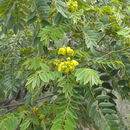Comprehensive Description
provided by North American Flora
Adipera tomentosa (L.f.) Britton & Rose
Cassia tomentosa L.f. Suppl. 231. 1781.
Cassia multiglandiilosa Jacq. Ic. PI. Rar. 1: 8. 1786.
A shrub or small tree, 2-4 m. high, the branches, inflorescence, petioles and rachis yellowishtomentose. Stipules linear, small, caducous; leaflets 6-8 pairs, lanceolate to oblong, acute or obtuse, mucronate, 1-6 cm. long, glabrate or loosely pubescent above, tomentose beneath; rachis bearing a gland between some or all the pairs of leaflets; inflorescence axillary, or terminal and paniculate; sepals orbicular, obtuse, pubescent, about 9 mm. long; petals 12-15 mm. long; three of the stamens on longer filaments than the others, slightly curved; anthers beakless; ovary densely lanate, tipped by the slender persistent style; legume 8-12 cm. long, compressedturgid; seeds numerous, shining, 5 mm. long.
Type locality: South America.
Distribution: Hidalgo to Guatemala. Colombia to Bolivia, Chile and Argentina.
- bibliographic citation
- Nathaniel Lord Britton and Joseph Nelson Rose. 1928. (ROSALES); MIMOSACEAE. North American flora. vol 23(1). New York Botanical Garden, New York, NY
Physical Description
provided by USDA PLANTS text
Perennial, Trees, Shrubs, Woody throughout, Stems woody below, or from woody crown or caudex, Plants with rhizomes or suckers, Stems erect or ascending, Stems or branches arching, spreading or decumbent, Stems 1-2 m tall, Stems greater than 2 m tall, Stems solid, Stems or young twigs sparsely to densely hairy, Leaves alternate, Leaves petiolate, Extrafloral nectary glands on petiole, Stipules inconspicuous, absent, or caducous, Stipules setiform, subulate or acicular, Stipules deciduous, Stipules free, Leaves compound, Leaves even pinnate, Leaf or leaflet margins entire, Leaflets opposite, Leaflets 10-many, Leaves hairy on one or both surfaces, Flowers in axillary clusters or few-floweredracemes, 2-6 flowers, Inflorescences racemes, Inflorescence panicles, Inflorescen ce axillary, Bracts very small, absent or caducous, Flowers actinomorphic or somewhat irregular, Calyx 5-lobed, Calyx hairy, Petals separate, Petals orange or yellow, Stamens 9-10, Fertile stamens 6-8, Stamens heteromorphic, graded in size, Stamens completely free, separate, Filaments glabrous, Anthers opening by basal or terminal pores or slits, Style terete, Fruit a legume, Fruit stipitate, Fruit unilocular, Fruit tardily or weakly dehiscent, Fruit indehiscent, Fruit elongate, straight, Fruit oblong or ellipsoidal, Fruit coriaceous or becoming woody, Fruit exserted from calyx, Fruit inflated or turgid, Fruit compressed between seeds, Fruit glabrous or glabrate, Fruit hairy, Fruit 11-many seeded, Seed with elliptical line or depression, pleurogram, Seeds ovoid to rounded in outline, Seed surface smooth, Seeds olive, brown, or black.
Senna multiglandulosa: Brief Summary
provided by wikipedia EN
Senna multiglandulosa is a species of flowering plant in the legume family known by several common names, including glandular senna, downy senna, and buttercup bush. It is native to Mexico, Guatemala, and western parts of South America, but it is widely cultivated as an ornamental plant and in some areas of the world has become naturalized in the wild. In some places it is considered a weed, for example, in New Zealand and New South Wales.
- license
- cc-by-sa-3.0
- copyright
- Wikipedia authors and editors

